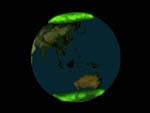
The magnetic field of the earth interacts with charged particles from the sun to create auroras circling the polar regions
Magnetism of the Planets
The Earth
The Earth has a magnetic field.
Compasses line up with the magnetic field of the earth.
The magnetic field has a north and a south pole. It is called a dipole field. The north magnetic pole is located just off the coast of Antarctica (yes, the north magnetic pole is located near the south geographic pole.)
Here is a space photo of the Northern and Southern Auroras of the earth superimposed on a model of earth.

The magnetic field of the earth interacts with charged
particles from the sun to create auroras circling the polar
regions
The magnetic field of the earth is made by a billion ampere electric current which circulates within the liquid metal of the outer core of the earth. (The liquid metal outer core stretches from the solid metal inner core about a quarter of the radius of the earth to the rocky mantle which begins 1/2 way from the core to the surface.)
When molten rocks which contain iron, cool in the presence of a magnetic field they record the magnetic field direction. We can look at the magnetic field recorded in the rocks and find out about the magnetic field of the earth in the past, the paleomagnetic field.
The paleomagnetic field shows that the magnetic field of the earth has flipped its direction many times. The flipping of the poles occurs after times of hundreds of thousands of years. It does not reverse on a regular basis but reverses chaotically.
The molten rocks spreading from mid ocean ridges record the flipping of the earths poles as bands of north and south magnetized rock
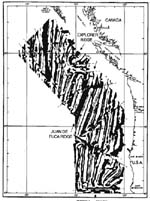
Magnetic stripes recorded in volcanic rocks underlying Pacific
Ocean off the northwest coast of the U.S.
Black is south pole up, white is north pole up.
(Twice in the record the field has not flipped for over 10 million years.)
The flip takes a few thousand years.
The last reversal was 780,000 years ago.
American Scientist Nov 1996 p 552 "The Reversal of the Earth's Magnetic Field"
Read what expert magnetic field geologists have to say about the reversal of the earth's magnetic field. at http://www.sciam.com/askexpert/geology/geology9/geology9.html
The magnetic field stretches out into space around the earth, a region known as the Earth's magnetosphere. It traps charged particle from the sun into two regions known as the Van Allen radiation belts.
The Planets
All planets with strong magnetic fields rotate rapidly (at least once every few earth days) and also contain an electrically conducting liquid.
Planet relative strength at surface equator field gauss conductor in planet tilt of magnetic axis Earth molten nickel iron 10.8 ° Mercury Venus Mars Jupiter metallic hydrogen 9.6° Saturn metallic hydrogen <1° Uranus water,methane,ammonia 58.6° Neptune water,methane,ammonia 47°
Table from the book The New Solar System
Jupiter
The magnetic field of Jupiter is revealed by its strong aurora.
Ultraviolet image of the Auroras on Jupiter from Hubble.
http://oposite.stsci.edu/pubinfo/PR/2000/38/content/0038w.jpg
Saturn
Hubble also shows the aurora on Saturn.
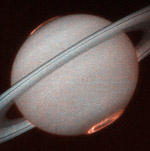
Aurora surrounding the poles of Saturn.
http://oposite.stsci.edu/pubinfo/pr/1998/05/content/9805w.jpg
Mars
Mars does not have a strong dipole magnetic field and so does not have auroras circling its poles. However at one time it had a strong magnetic field which was recorded in molten volcanic rocks creating stripes like those due to continental drift on earth.
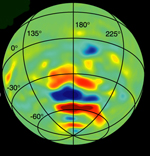
Red and Blue stripes on Mars record an ancient Martian
magnetic field which changed its polarity.
http://mgs-mager.gsfc.nasa.gov/publications/grl_28_connerney/images/grl_28_connerney_cover_black.jpg
Sun
The sun has a strong magnetic field that reverses polarity every 11 years creating the sunspot cycle.
Sunspots themselves have strong magnetic fields, they come in pairs with a north pole spot next to a south pole spot. The glowing solar plasma follows the field lines of sunspots creating a pattern like the one produced by sprinkling iron filings onto a simple bar magnet.
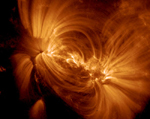
Glowing plasma follows the magnetic field of sunspots on the
surface of the sun.
http://vestige.lmsal.com/TRACE/Science/ScientificResults/trace_cdrom/html/trace_images.html
|
Scientific Explorations with Paul Doherty |
|
17 March 2002 |